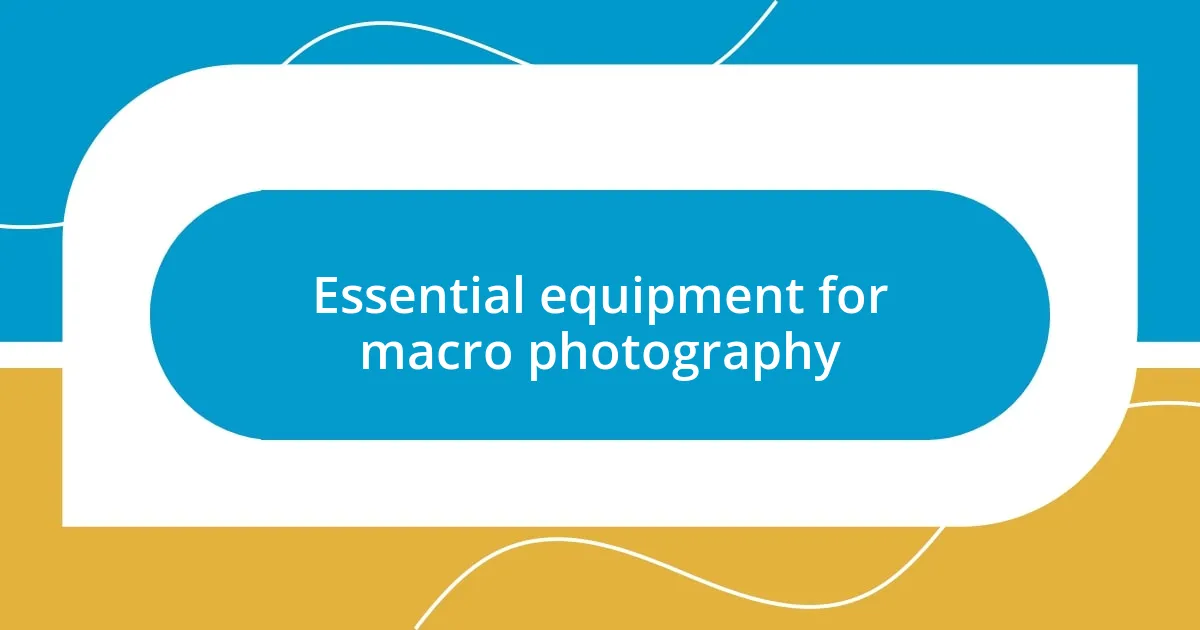Key takeaways:
- The author discovered macro photography during a nature walk, leading to a deep appreciation for the intricate details of small subjects.
- Essential equipment for macro photography includes a macro lens, tripod, lighting tools, extension tubes, and remote shutter release for capturing sharp images.
- Understanding and manipulating lighting, whether natural or artificial, is crucial for enhancing details and mood in macro photography.
- Sharing macro work on social media and participating in photography competitions fosters connections and recognition within the photography community.

My introduction to macro photography
I stumbled upon macro photography almost by accident during a nature walk. Armed with a basic camera, I was captivated by the intricate details of a tiny ladybug crawling on a leaf. How could something so small hold such beauty? That moment ignited a spark within me, compelling me to explore this fascinating world of minute wonders.
Soon after, I invested in my first macro lens. I still remember the thrill of attaching it to my camera for the first time—it felt like unlocking a new dimension. I ventured into my garden, and as I focused on a dewdrop perched delicately on a petal, I was struck by how the simplest subjects could evoke profound emotions. I felt a rich connection to nature, seeing everyday scenes transformed into breathtaking art.
As I delved deeper, I began to understand the patience and technique required in macro photography. Each shoot demanded focus and attention to detail, but the rewards were immense. I realized that capturing these tiny moments allowed me to appreciate the beauty often overlooked in our fast-paced lives. Have you ever experienced a similar revelation while pursuing something you love? It’s moments like these that can truly change your perspective.

Essential equipment for macro photography
For macro photography, selecting the right equipment is crucial to capturing those tiny details that often go unnoticed. I remember feeling overwhelmed by options when I was starting out; it felt like there was a whole new language I had to learn. However, once I gathered my essential gear, everything started to click into place.
Here are some must-have items for anyone serious about exploring the world of macro photography:
- Macro Lens: This is the cornerstone of macro photography. A dedicated macro lens allows you to get up close and personal with your subject, often with a magnification of 1:1 or greater. I discovered mine opened up a new universe in my garden.
- Tripod: A steady tripod minimizes camera shake, which can be a game-changer when you’re working with such fine details. I recall setting up my tripod next to a blooming flower, waiting patiently for the perfect shot.
- Lighting: Natural light can be unpredictable, so a good ring light or portable LED can help illuminate your subject beautifully. I once used a small LED light to highlight the iridescent colors of a butterfly’s wings, and the results were magical.
- Extension Tubes: These allow you to get closer to your subjects without having to invest in a dedicated macro lens right away. I’ve used them to photograph dew droplets on grass blades, which made for stunning images.
- Remote Shutter Release: This tool helps reduce vibration when taking the shot. I found it especially useful when capturing delicate insects that tend to twitch at the slightest disturbance.
Investing in the right equipment not only enhances your capability but also boosts your confidence. Once I secured my gear, I felt like a true artist ready to capture the beauty of the small world around me.

Understanding lighting in macro photography
Understanding lighting in macro photography can significantly transform your images. Lighting plays a vital role in how details are highlighted or subdued, affecting the overall mood of your shots. I still remember the first time I experimented with backlighting while photographing an insect. The sun filtered through its delicate wings, creating a masterpiece that I couldn’t have achieved with flat lighting.
When shooting close-ups, natural light can be both a friend and a foe. On bright days, the harsh sunlight can create unflattering shadows, while overcast days soften the light beautifully. I recall a particular rainy afternoon when I ventured outside. The diffused light brought out the rich colors of the flowers, and as I captured a close-up shot, I felt a sense of calm wash over me, reminiscent of a watercolor painting coming to life.
Additionally, artificial lighting can be a game-changer in macro photography. Experimenting with diffused flash or LED lights can help eliminate shadows and enhance textures. I once set up a small LED panel aiming to bring out the minute textures of a snail’s shell. The way the light danced off the surface made me feel like I was looking at a miniature planet under a microscope.
| Lighting Type | Effects |
|---|---|
| Natural Light | Varies greatly; can produce harsh shadows or soft, diffused light depending on conditions. |
| Backlighting | Creates transparency and depth, enhancing colors and details behind the subject. |
| Artificial Light | Provides control over lighting conditions; can be used to eliminate shadows and highlight textures. |
| Diffused Light | Softens the overall light, reducing harsh contrasts and creating a gentle atmosphere. |

Techniques for getting sharp images
When it comes to achieving sharp images in macro photography, focus is everything. I learned early on that using manual focus was often more effective than relying on autofocus, especially when photographing fast-moving subjects like bees. Have you ever tried getting a crisp shot of a rapidly flapping wing? It can be challenging, but taking that extra moment to adjust the focus manually makes a huge difference.
Another technique I found invaluable is using a small aperture. By closing down the aperture (like f/16 or f/22), you increase the depth of field. This helps keep more of your subject in focus, which is crucial in macro where the range is often very shallow. I still remember the first image I took that was sharp from tip to tail of a dragonfly—such an exhilarating moment!
Finally, stabilizing your camera is key to sharpness. I often use my tripod in combination with the camera’s timer function. Have you ever felt that slight heartbeat of excitement right before capturing the shot? I find that waiting for those few seconds after pressing the shutter allows any potential movement to settle, giving me the best chance at crisp detail. Each of these methods has contributed to the beautiful clarity I now see in my macro images.

Creative composition in macro photography
Creative composition in macro photography can open up endless possibilities for stunning visuals. I will never forget the day I captured a close-up of a dewdrop on a leaf. By framing the droplet against the surrounding foliage, I created a sense of depth that turned a simple shot into a miniature world. Isn’t it amazing how shifting your perspective can unveil hidden beauty?
Balancing elements in your frame is also crucial. I often experiment with leading lines in my compositions, like capturing a tiny insect crawling along a curvy stem. This technique draws the viewer’s eye towards the subject while adding a natural flow to the image. It’s a bit like telling a story—each element contributes to the narrative you want to convey.
Don’t shy away from negative space either. I remember a shot where I intentionally left a lot of blank space around a solitary flower. The emptiness allowed the subject to breathe and really stand out. Have you ever tried that? It can evoke a powerful emotional response, highlighting the fragility and beauty of nature in a way that’s both simple and profound.

Post-processing tips for macro shots
Post-processing can take your macro shots to the next level, enhancing the intricate details that might otherwise go unnoticed. I often start my editing by adjusting the exposure and contrast to ensure that textures pop—in macro photography, it’s all about those tiny details. Once, I applied a subtle increase in clarity to a close-up of a flower’s petals, revealing the delicate veins that almost seemed to dance against the light. Have you ever noticed how such small adjustments can completely transform an image?
Color correction is also an essential part of my workflow. I recall editing an image where the vibrant colors of a beetle were dulled out by inadequate lighting. By selectively enhancing the saturation, I was able to bring out the brilliant greens and blues, making the photo almost come alive. It’s like adding a fresh coat of paint to a beloved masterpiece—sometimes, it just needs that little extra touch to make it shine.
Another crucial tip involves sharpening your images without going overboard. I remember the first time I cranked up the sharpening slider too high and ended up with a distracting halo effect around my subject. Now, I apply sharpening selectively, often using a brush tool just on the details that matter, like the eyes of an insect. Have you considered how fine-tuning those minute details can direct a viewer’s gaze? It’s all about creating a captivating experience that keeps them engaged, isn’t it?

Sharing and showcasing macro work
Sharing my macro work has been an incredibly rewarding journey. I love posting my images on social media platforms dedicated to photography, where I can connect with fellow enthusiasts. I vividly recall the thrill when I uploaded my first macro shot of a butterfly resting on a flower, and the influx of positive feedback made me feel part of a vibrant community. Isn’t it incredible how sharing a simple photo can forge connections across the globe?
When it comes to showcasing my macro photography, I often explore the idea of themed collections. Last spring, for example, I created a series centered around the beauty of insects in their natural habitats. Each piece told a story, capturing the delicate interplay between the creatures and their environment. By arranging them in a cohesive presentation, I provided viewers with a rich viewing experience, evoking curiosity about these fascinating little worlds. Have you ever considered how planning a visual narrative can elevate your work?
Finally, I find that entering photography competitions is another fantastic way to showcase my macro images. The excitement of preparing a submission—carefully selecting which shot best represents my style—and waiting for the results never fails to ignite my passion. I still remember the day I received commendation for an intense close-up of a spider weaving its web. The recognition was a reminder of how much I’ve grown as a photographer. Have you thought about putting your work out there for others to see? You might be pleasantly surprised by the response!














